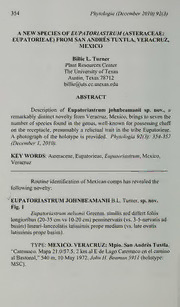
A new species of Eupatoriastrum (Asteraceae: Eupatorieae) from San Andrés Tuxtla, Veracruz, Mexico PDF
Preview A new species of Eupatoriastrum (Asteraceae: Eupatorieae) from San Andrés Tuxtla, Veracruz, Mexico
354 Phytologia (December2010) 92(3) A NEW SPECIES OFEUPATORIASTRUM(ASTERACEAE: EUPATORIEAE) FROM SAN ANDRES TUXTLA, VERACRUZ, MEXICO Billie L. Turner Plant Resources Center The University ofTexas Austin, Texas 78712 [email protected] ABSTRACT Description of Eupatoriastrum johnbeamanii sp. nov., a remarkably distinct novelty from Veracruz, Mexico, brings to seven the number ofspecies found in the genus, well-known for possessing chaff on the receptacle, presumably a relictual trait in the tribe Eupatorieae. A photograph ofthe holotype is provided. Phytologia 92(3): 354-357 (December 1, 2010). KEY WORDS: Asteraceae, Eupatorieae, Eupatoriastrum, Mexico, Veracruz Routine identification ofMexican comps has revealed the following novelty: EUPATORIASTRUM JOHNBEAMANII B.L. Turner, sp. nov. Fig.l Eupatoriastrum nelsonii Greenm. similis sed differt foliis longioribus (20-35 cm vs 10-20 cm) penninervatis (vs. 3-5-nervatis ad basim) lineari-lanceolatis latissimis prope medium (vs. late ovatis latissimis prope basim). TYPE: MEXICO. VERACRUZ: Mpio. San Andres Tuxtla, "Catemaco. Mapa 21.0/57.5, 2 km al E de Lago Catemaco en el camino al Bastonal," 540 m, 10 May 1972,John H. Beaman 5911 (holotype: MSC). Phytologia (December2010) 92(3) 355 m Suffruticose perennial herbs or shrublets 1.0-2.5 high. Stems to 1 cm thick, pubescent with short stout, spreading, trichomes, the vestiture ca 0.5 mm high. Leaves very large (20-35 cm long, 6-10 cm across), alternate, penninervate, linear-lanceolate, widest at or near the middle, essentially glabrous above and below, except along the major veins; petioles 1-4 cm long, grading into the blades, the margins entire below, weakly serrate above. Capitulescence a large (many- headed), terminal, cymose panicle, the ultimate peduncles 1-3 cm long. mm mm Heads broadly campanulate, ca 12 high, 15 across. mm Receptacles convex, glabrous, ca 3 across, paleate throughout. Involucral bracts 6-8 seriate, imbricate, the innermost linear- lanceolate, scarious, glabrous, the apices rounded, grading into the mm palea. Florets numerous (100+); corollas yellow, ca 6 long, mm mm glabrous or nearly so; tubes ca 3 long, the lobes ca 0.5 long, ornate with golden glandular globules. Anther appendages narrowly mm triangular, ca 0.5 long. Achenes black, weakly 3-5 sided, sparsely pubescent, the podia well-developed; pappus ofnumerous bristles 5-6 mm long. ADDITIONAL COLLECTIONS: MEXICO. VERACRUZ: Mpio. W San Andres Tuxtla, "Mapa 23.0/55.0, lado de Cerro Mastagaga ca. 13 km al N.E. de San Andres Tuxtla," 1200 m, 29 Jan 1972, Beaman 5553 (MSC, 2 sheets). Other than features ofleafmorphology, as noted in the above diagnosis, Eupatoriastrum johnbeamanii differs from E. nelsonii in numerous other characters, including capitulescence (many-headed, terminal panicles vs. few-headed, axillary cymes), involucres 6-8 seriate (vs 3-5 seriate), and yet other features ofthe capitula. Eupatoriastrum is a relatively rare genus confined largely to Mexico. Turner (1997) provided an account ofthe five species known to him at the time, four ofthese illustrated with full-page figures. An additional species was subsequently added to the genus (Turner 2008); the presentnovelty brings the total to seven. The species is named for my long-time friend and colleague John Beaman. We both worked at Washington State University under the tutelage of the late Marion Ownbey at the same time (he for a 356 Phytologia (December2010) 92(3) masters; me for a doctorate). John went on to obtain his doctorate under Reed Rollins at Harvard and has become widely known for his extraordinary botanical studies on Mount Kinabalu, largely working out ofKEW. I have used his first name in my eponym so as to distinguish him from his son Reed, who also is widely known for his contributions to Asian Botany. ACKNOWLEDGEMENTS I am grateful to my colleague Guy Nesom forthe Latin diagnosis and to my academic son Alan Prather forcalling my attention to the plants concerned. LITERATURE CITED: Turner, B.L. 1997. Eupatoriastrum, in The Comps ofMexico, Vol. 1. Phytologia Memoirs 93-99. 1 1: Turner, B.L. 2008. Eupatoriastrumpochutlanum (Asteraceae: Eupatorieae), a new species from Oaxaca, Mexico. Phytologia 90: 355-356. Fig. 1. Eupatohastrumjohnbeamanii (holotype: MSC).
